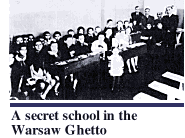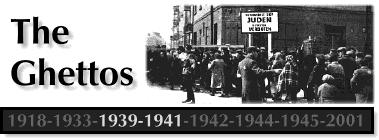|
Many of the ghetto dwellers were from the local area. Others were from
neighboring villages. In October 1941, general deportations began from
Germany to major ghettos in Poland and further east. Also, Jews from
Austria and the Protectorate of Bohemia and Moravia were sent to the ghettos.
 Ghetto life was wretched. The ghettos were filthy, with poor sanitation. Extreme
overcrowding forced many people to share a room. Disease was rampant.
Staying warm was difficult during bitter cold winters without adequate warm
clothes and heating fuel. Food was in such short supply that many
slowly starved to death.
Ghetto life was wretched. The ghettos were filthy, with poor sanitation. Extreme
overcrowding forced many people to share a room. Disease was rampant.
Staying warm was difficult during bitter cold winters without adequate warm
clothes and heating fuel. Food was in such short supply that many
slowly starved to death.
 Additional notes on ghetto nutrition including examples of daily caloric rations. Additional notes on ghetto nutrition including examples of daily caloric rations.
Even in the midst of these horrible conditions, many ghetto dwellers
resisted dehumanization. Parents continued to educate their children,
although it was considered an illegal activity. Some residents secretly continued
to hold religious services and observe Jewish holidays.
The Nazis established the Theresienstadt  (or Terezín) (or Terezín) ghetto in northwestern Czechoslovakia as a so-called model Jewish settlement to
counter rumors in the international community about the poor conditions in
the ghettos. Flower gardens, cafés, and schools were constructed to
demonstrate to visiting International Red Cross inspectors and audiences of
Nazi propaganda films the humane conditions of a "typical" ghetto. Terezín
also functioned as a transit camp for many who were later sent to Auschwitz ghetto in northwestern Czechoslovakia as a so-called model Jewish settlement to
counter rumors in the international community about the poor conditions in
the ghettos. Flower gardens, cafés, and schools were constructed to
demonstrate to visiting International Red Cross inspectors and audiences of
Nazi propaganda films the humane conditions of a "typical" ghetto. Terezín
also functioned as a transit camp for many who were later sent to Auschwitz  or other death camps. or other death camps.
 Visit the Janusz Korczak site to learn more about the teacher who resisted by carrying on his work in an orphanage in the Warsaw Ghetto. Visit the Janusz Korczak site to learn more about the teacher who resisted by carrying on his work in an orphanage in the Warsaw Ghetto.
 More information about
Terezín, before, during, and after the war, is available at this Web site. More information about
Terezín, before, during, and after the war, is available at this Web site.
 Photographs, maps, and an article about the Theresienstadt ghetto. Photographs, maps, and an article about the Theresienstadt ghetto.
 The story of Valie Borsky who spent four years in Theresienstadt. The story of Valie Borsky who spent four years in Theresienstadt.
 Scenes of Warsaw ghetto life including arrival of inmates, the Jewish police, and the walls. Scenes of Warsaw ghetto life including arrival of inmates, the Jewish police, and the walls.
 Scenes of Warsaw ghetto life including crowded streets, forced labor, smuggling, and homeless children. Scenes of Warsaw ghetto life including crowded streets, forced labor, smuggling, and homeless children.
 Images of life in other Polish ghettos outside of Warsaw including a marketplace, an execution, and a ghetto newspaper. Images of life in other Polish ghettos outside of Warsaw including a marketplace, an execution, and a ghetto newspaper.
 Artworks by four ghetto artists. Artworks by four ghetto artists.
 Many photographs of life (and death) in the ghettos. Many photographs of life (and death) in the ghettos.
 A history of the Vilna ghetto including maps, documents, and many photographs. A history of the Vilna ghetto including maps, documents, and many photographs.
 "The Cultural Life of the Vilna Ghetto" by Solon Beinfeld. "The Cultural Life of the Vilna Ghetto" by Solon Beinfeld.
 Photographs, documents, maps and an extensive article about the Lodz ghetto. Photographs, documents, maps and an extensive article about the Lodz ghetto.
 Photographs, maps and an article about the Lvov ghetto. Photographs, maps and an article about the Lvov ghetto.
 Read a translation of Kovno Ghetto Diary by Dmitri Gelpernus. Read a translation of Kovno Ghetto Diary by Dmitri Gelpernus.
The Nazis undertook to liquidate the ghettos as they began full implementation
of "The Final Solution to the Jewish Question"  in 1942. Massive deportations of Jews to concentration and death camps continued until the summer of 1944. By that time, almost all of the ghettos had been liquidated. in 1942. Massive deportations of Jews to concentration and death camps continued until the summer of 1944. By that time, almost all of the ghettos had been liquidated.
 Interactive quiz on the ghettos. Interactive quiz on the ghettos.
 Lesson plans, discussion questions, term paper topics, reproducible handouts, and other resources for teaching about the ghettos are available here. Lesson plans, discussion questions, term paper topics, reproducible handouts, and other resources for teaching about the ghettos are available here.
| Nazi Party
| Nazification
| Ghettos
| Camps
| Resistance
| Liberation
| Aftermath
|


A Teacher's Guide to the Holocaust
Produced by the Florida Center for Instructional Technology,
College of Education, University of South Florida © 2005.
| 
